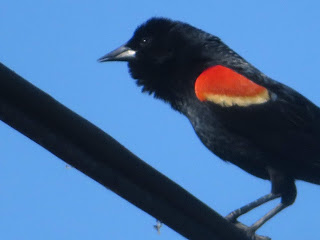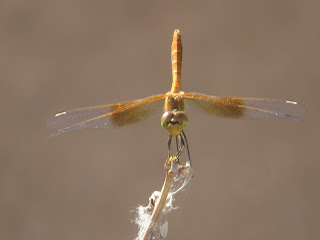Most people see the Corrales interior ditch slowly drying out and see a useless, fetid swamp. Others mourn the effects of climate change. Some see changing land use patterns in Corrales. But can you also see the vibrant ecosystem of birds and other organisms that depend on just this transition to be able to thrive?
Transition zones, such as where water meets land are famously diverse and attractive to fascinating species and cultures. Humans came down from the trees and out into the grasslands in just such a boundary zone (out competing at least eight other human species in the process.)
The coopers hawks are very well adapted to life along the river, they are also appreciative of the bird feed put out to attract their dinner. They are very much at home in dense branches and have thrived where humans live.
Roadrunners are adaptable to birds, eating snails in the wet season and lizards during dry times. They are often seen chasing the slowest lizards along paved pedestrian paths
Barn Swallows have found cliffs to be inferior to man-made traffic bridges and have moved in large numbers to the river. Adapting to the constant traffic above seems to not have been a problem for them.
Many birds are still actively defending nests. The large raptors are tormented mercilessly while roosting by birds such as this tyrant flycatcher. Nesting season is why the ravens and turkey vultures are found in the open plains this time of year.
Red swamp crayfish are not a native species, but thrive in the shallow waters of the ditches. They eat anything, and combine an ability to move fast in water, with formidable pincers and fast reproduction.
The odds seem to be stacked again the defenseless tadpoles like this wood-house toad, but they are tenacious and abundant at this time of year. They cope well against many predators by being both numerous and also toxic when older.
This large garter snake is semi-aquatic and an active hunters of tadpoles. This one is quite large and exposed, so it is in a hurry to get back to the relative safety of water. Open land and open skies is quite a risk for this species.
Toads make some drastic lifestyle changes as the adjust from water breathing, vegetarian swimmers to air breathing insectivore hoppers. They must have learned something, amphibians have been around for 368 millions years. This metamorph is less than a width of a pinkie fingernail.
Leafhoppers are very common in dry trees. Rain often prevents them from feeding or reproducing, as with many small insects. So, to extend their time feeding and breeding leafhoppers produce a super-hydrophobic powder coating of bronchosomes to ward off both water and insecticides. This technology has been replicated by humans to protect walls near pubs from public urine. Leafhoppers also produce a constant sticky liquid rain as they feed on tree sap. This appears to distract ants and flies that could otherwise attack them. The weather is perfect for many dragonfly species that are usually found later in the summer. The range of colors that can be seen is pretty spectacular. The domination of the small meadowhawks is coming to an end, and the larger skimmers are coming out to replace them.
Hot, wet weather is also the time for many ant species to swarm. We are seeing many carpenter ant drones resting as they seek out others of their species. Most of the information found the internet is from pest control companies, who, obviously do not paint this complex insect in a very favorable light.
This is the ten lined June bug. We will see a lot more of these insects later in the summer, but this first wave was pretty small. These "false starts" of insect explosive growths are very common. When the sunflowers are taller, we should see many more of these around.
Lappet moths are named for the extra band of material found in front of the wing. The caterpillar has irritating hairs that can be uncomfortable if handled.
The largest flying insect was a dragonfly with a 2.3 foot long wingspan and was the ancestor to those dragonflies we see today.
Dragonflies are an ancient insect order and well adapted for a diet of midges and mosquitos. Like tadpoles they live as juveniles in the water (and can actually predate on tadpoles) and as adults they are active, insectivore fliers.
There are other insects that look a lot life dragonflies, such as these damselflies, dobsonflies and antlions
Praying mantis are a versatile species related to cockroaches and termites. While these insects look nothing alike, they all use the structure of an Ootheca to protect their eggs from the atmosphere and other insects.
Young praying mantis are also able to change their color over a period of weeks to better adapt to changing conditions.
This dragonfly is more unusual, a roseate skimmer found at the Harvey Jones channel outflow. While they are common, I have not seen them further south in Corrales. WE are actually very limited in the wetland area available to us here. Most people don't even notice how fragile our wetlands areas are (except those who listen to the diesel pumps that supply Corrales with irrigation water now)
Cicada live deep underground as grubs feeding on tree roots. During the hottest part of the summer they come up to reproduce. The males make a sound as loud as standing next to a smoke alarm going off.
The receding banks of the river is a boon to many plants, as well as animals. There, the grass is growing quickly in the newly exposed real estate of irrigated, fertilized and scarified soft ground..
Often there is clear strata in the wet clay. The water weed is stranded first, them the cotton fluff, then the seeds of the new sprouting cottonwoods.
The trees are still producing the downy fluffs familiar to all poplar tree species. The unfamiliar grape looking structures are tigtly packed with cotton and release in hot, humid days usually just before a thunderstorm.
Fire is always a risk in a heavily wooded area. Its odd that people need to complicate this risk by adding campfires into the mix. This one does not appear to have spread, but it seems so unnecessary.
This nondescript plant is a sandpuff. This plant actually prefers dry sandy soil. Luckily, this is exactly what there is in the newly landscaped region of Rio Rancho's effluent outflow.
Fish are amazingly adaptable, and some have evolved well to combat desiccation. Some estuary fish actually cannot breath in water. This large catfish, however was not able to adapt quickly enough.
The fence lizards do well in the high heat and plentiful insects that occur after a monsoon period. However, the riches also produce intense competition for the best sunning spots, often leading to fights that are rare during the rest of the season.
Bullfrogs are actually well adapted to muddy, flooded fields and cannot swim very well at all. They are amazing at being bullies to smaller frogs, however and can grow to large sizes over several years. This makes them larger and stronger, but far less agile when out of water.





























No comments:
Post a Comment